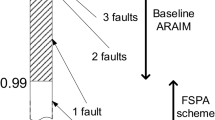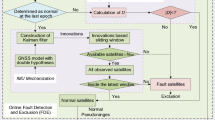Abstract
Since the traditional Maximum Likelihood-based range domain multiple reference consistency check (MRCC) has limitations in satisfying the integrity requirement of CAT II/III for civil aviation, a Kalman filter-based position domain method has been developed for fault detection and exclusion in the Local Area Augmentation System MRCC process. The position domain method developed in this paper seeks to address the limitations of range domain-based MRCC by focusing not only on improving the performance of the fault detection but also on the integrity risk requirement for MRCC. In addition, the issue of the stability of the Kalman filter in relation to the position domain approach is considered. GPS range corrections from multiple reference receivers are fused by the adaptive Kalman filter at the master station for detecting and excluding the single reference receiver’ failure. The performance of the developed Kalman filter-based MRCC has been compared with the traditional method using experimental data. The results reveal that the vertical protection level is slightly better in the traditional method compared with the developed Kalman filter-based approach under the fault-free case. However, the availability can be improved to over 97% in the proposed method relative to the traditional method under the single-fault case. Furthermore, the fault-tolerant positioning result with an accuracy improvement of more than 32% can be achieved even if different fault types are considered under the single-fault case. In particular, the algorithm can be a candidate option as an augmentable complement for the traditional MRCC and can be implemented in a master station element of the LAAS integrity monitoring architecture.








Similar content being viewed by others
References
Braff R (2001) LAAS performance for terminal area navigation. In: Proceedings of the 57th annual meeting of the Institute of Navigation, NM, pp 252–262
Crassdis J, Junkins J (2004) Optimal estimation of dynamical systems. Chapman & Hall/CRC, New York
Enge P (1999) Local area augmentation of GPS for the precision approach of aircraft. Proc IEEE 87(1):111–132
Gleason S, Gebre-Egziabher D (2009) GNSS application and methods. Artech House, New York
Gustafsson F (2005) Adaptive filtering and change detection. Wiley, New York
ICAO (1999) Manual on required navigation performance, 2nd edn
ICAO (2008) Performance-based navigation (PBN) annual, 3rd edn
Kelly R (2000) Comparison of LAAS B-values with linear model optimum B-values. J Inst Navig 47(2):143–156
Khanafseh S, Langel S, Pervan B (2009) H1-integrity of carrier phase navigation algorithms using multiple reference receivers. In: Proceedings of the 2009 international technical meeting of the Institute of Navigation, CA, pp 236–247
Liu F (1998) Analysis of integrity monitoring for the local area augmentation system using global navigation satellite system. PhD dissertation, Ohio University
Misra P, Enge P (2001) Global positioning system: signals, measurements, and performance. Ganga-Jamuna Press, Lincoln
Murphy T, Imrich T (2008) Implementation and operational use of ground-based augmentation systems—a component of future air traffic management system. Proc IEEE 96(12):1936–1957
Ochieng W, Sauer K, Walsh D, Brodin G, Griffin S, Denny M (2003) GPS integrity and potential impact on aviation safety. J Navig 56(1):51–65
Pervan B, Sayim I (2001) Sigma inflation for the local area augmentation of GPS. IEEE Trans Aerosp Electron Syst 37(4):1301–1311
Pervan B, Pullen S, Christie R (1998) A multiple hypothesis approach to satellite navigation integrity. J Inst Navig 45(1):61–71
RTCA (2004) Minimum aviation system performance standards for Local Area Augmentation System (LAAS). Issued 28 Sept 1998, prepared by SC-159
Shively C (1999) Performance analysis of alternative methods for LAAS multiple reference consistency. J Navig 46(1):65–86
Tang H, Pullen S, Enge P, Gratton L, Pervan B, Brenner M, Scheitlin J, Kline P (2010) Ephemeris type A fault analysis and mitigation for LAAS. In: Proceedings of IEEE/ION PLANS 2010, CA, pp 654–666
Walter T, Enge P, Blanch J, Pervan B (2008) Worldwide vertical guidance of aircraft based on modernized GPS and new integrity augmentations. Proc IEEE 96(12):1918–1935
Wen H, Havlicek J, Fagan J (2004) B-value research for FAA LAAS station integrity and fault detection. In: Proceedings of the 2004 national technical meeting of the Institute of Navigation, CA, pp 817–822
Acknowledgments
We gratefully acknowledge the financial support from the Chinese Scholarship Council (CSC) which allows Liang Li to carry out research for 1 year at Loughborough University, United Kingdom. We would like to thank Dr. Rene Wackrow, Dr. Yuheng Zheng, and Mr. Nick Rodgers for their assistance in constructing the MRCC test bed and collecting the GPS data. The work was partly funded by the UK Engineering and Physical Sciences Research Council (Grant reference EP/F018894/1).
Author information
Authors and Affiliations
Corresponding author
Appendices
Appendix 1
The mathematical induction method is used to prove \( \user2{P}_{{{{\rm v}}_{0,i} ,k}} = \user2{P}_{{{{\rm v}}_{0} ,k}} \). For k = 0, we have \( \user2{P}_{{{{\rm v}}_{0,i} ,0}} = \user2{P}_{{{{\rm v}}_{0} ,0}} = {\bar{\varvec P}}_{0} \), which is satisfied by (12). Assume \( \user2{P}_{{{{\rm v}}_{0,i} ,l - 1}} = \user2{P}_{{{{\rm v}}_{0} ,l - 1}} \) is true for some positive integer l. Then for k = 1, we have
Substitute (14) and the predetermined assumption \( \user2{P}_{{{{\rm v}}_{0,i} ,l - 1}} = \user2{P}_{{{{\rm v}}_{0} ,l - 1}} \) into (25), we have:
According to the Kalman filter theory, the following can be obtained:
and
Substitute (28) and (26) into (15), we have
Hence \( \user2{P}_{{{{\rm v}}_{0,i} ,l}} = \user2{P}_{{{{\rm v}}_{0} ,l}} \) is satisfied for k = 1.
Appendix 2
Begin with (23),
which is equal to (24). In which \( \text{erfc} (x) = \frac{1}{\sqrt \pi }\int_{x}^{\infty } {\exp \left( { - t^{2} } \right)\text{d} t} \) is a built-in function in Matlab.
Rights and permissions
About this article
Cite this article
Li, L., Quddus, M., Ison, S. et al. Multiple reference consistency check for LAAS: a novel position domain approach. GPS Solut 16, 209–220 (2012). https://doi.org/10.1007/s10291-011-0223-y
Received:
Accepted:
Published:
Issue Date:
DOI: https://doi.org/10.1007/s10291-011-0223-y




